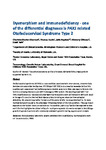Dysmorphism and immunodeficiency - one of the differential diagnoses is PAX1 related Otofaciocervical Syndrome Type 2
| dc.contributor.author | Baptista, Julia | |
| dc.date.accessioned | 2022-05-12T14:57:13Z | |
| dc.date.issued | 2022-07 | |
| dc.identifier.issn | 1769-7212 | |
| dc.identifier.issn | 1878-0849 | |
| dc.identifier.other | 104523 | |
| dc.identifier.uri | http://hdl.handle.net/10026.1/19219 | |
| dc.description | File replaced (incorrect version) on 1/5/22 by KT (LDS). | |
| dc.description.abstract |
Otofaciocervical syndrome (OTFCS) is a rare condition associated with short stature, abnormal facial features and conductive hearing loss. OTFCS type 2 (OTFCS) is an autosomal recessive form of this condition with associated T cell deficiency due to biallelic variants in PAX1. We report a female child born to a consanguineous couple with homozygous PAX1 variant. She was diagnosed with T cell immunodeficiency as a neonate and underwent haematopoietic stem cell transplant with cord blood at the age of 5 months. She had facial dysmorphism including ear abnormalities and spinal deformity. We present longitudinal follow-up of the proband who has responded well to the bone marrow transplant to add to the otherwise limited description of this rare condition. This case report expands on the limited literature available on this condition, with only five families reported to date and it further highlights the clinical utility of a rapid gene-agnostic trio exome analysis in identifying a genetic diagnosis in patients who previously underwent genomic testing by gene panel analysis. | |
| dc.format.extent | 104523-104523 | |
| dc.format.medium | Print-Electronic | |
| dc.language | en | |
| dc.language.iso | en | |
| dc.publisher | Elsevier BV | |
| dc.subject | Otofaciocervical syndrome | |
| dc.subject | Severe combined immunodeficiency | |
| dc.subject | Haematopoietic stem cell transplantation | |
| dc.subject | PAX1 | |
| dc.title | Dysmorphism and immunodeficiency - one of the differential diagnoses is PAX1 related Otofaciocervical Syndrome Type 2 | |
| dc.type | journal-article | |
| dc.type | Case Reports | |
| dc.type | Journal Article | |
| plymouth.author-url | https://www.webofscience.com/api/gateway?GWVersion=2&SrcApp=PARTNER_APP&SrcAuth=LinksAMR&KeyUT=WOS:000804408800002&DestLinkType=FullRecord&DestApp=ALL_WOS&UsrCustomerID=11bb513d99f797142bcfeffcc58ea008 | |
| plymouth.issue | 7 | |
| plymouth.volume | 65 | |
| plymouth.publication-status | Published | |
| plymouth.journal | European Journal of Medical Genetics | |
| dc.identifier.doi | 10.1016/j.ejmg.2022.104523 | |
| plymouth.organisational-group | /Plymouth | |
| plymouth.organisational-group | /Plymouth/Faculty of Health | |
| plymouth.organisational-group | /Plymouth/Faculty of Health/Peninsula Medical School | |
| plymouth.organisational-group | /Plymouth/Users by role | |
| plymouth.organisational-group | /Plymouth/Users by role/Academics | |
| dc.publisher.place | Netherlands | |
| dcterms.dateAccepted | 2022-05-11 | |
| dc.rights.embargodate | 2023-5-17 | |
| dc.identifier.eissn | 1878-0849 | |
| dc.rights.embargoperiod | Not known | |
| rioxxterms.versionofrecord | 10.1016/j.ejmg.2022.104523 | |
| rioxxterms.licenseref.uri | http://www.rioxx.net/licenses/all-rights-reserved | |
| rioxxterms.type | Journal Article/Review |


